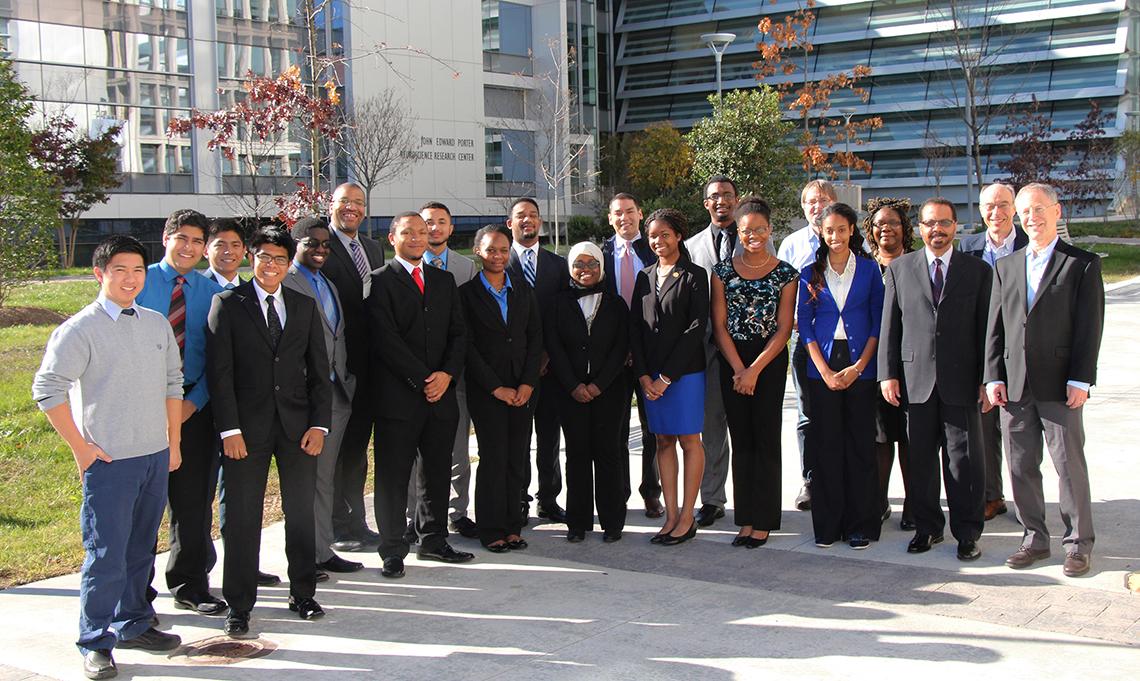UMBC Meyerhoff Scholars Visit NIH

Photo: Raymond Macdougall
Undergraduate students from the University of Maryland, Baltimore County, toured bioengineering labs and learned about NIH training opportunities during a recent visit to NIH organized by the National Institute of Biomedical Imaging and Bioengineering’s Division of Interdisciplinary Training. The 14 students are part of the Meyerhoff Scholarship Program, renowned for a 25-year record of advancing diversity among leaders in science and engineering. A high percentage of students in the program go on to earn M.D. and Ph.D. degrees.
NIBIB director Dr. Roderic Pettigrew welcomed the group and reminisced about the lesson that sparked his interest in science at a young age. In his mother’s car, after a class about the Bernoulli principle of aerodynamic lift, wind picked up and tossed papers out the car window. Then, back home, he realized that the vacuum cleaner also demonstrated the principle. “I remember when I was their age and how science held my attention during otherwise turbulent times during the Civil Rights era in the South,” he said. “The Meyerhoff Scholars Program is exceptional at recruiting students who have that spark of interest and supporting their engagement in science and engineering.”
About 300 students attend UMBC as Meyerhoff scholars, according to Keith Harmon, director of the program at UMBC, who accompanied the contingent. About 48 percent of those students study life sciences. “They’re seeing cutting-edge technologies and where the fields are going—things they may not have been exposed to at UMBC or in their summer internships,” he said, during a tour of Bldg. 13’s imaging laboratories. “They are also interacting with professionals and really continuing to develop their own scientific identity, seeing where their training and career options lie for the years ahead.”
Presentations by NIBIB intramural researchers featured super-resolution microscopy of round- worm embryos; an explanation of the bioimaging revolution that has accompanied the discovery of green fluorescent protein from jellyfish and the subsequent development of other photosensitive and photo-activatable spectral probes; an explanation of biochemical principles underlying dynamic protein interactions; and the steps by which imaging is being used to create 3-D models of brain structures.
Senior class member Hilary Bright signed on for the NIH tour as an opportunity to immerse herself in the life sciences. As a biochemistry major, her typical focus is on more technical areas of science. She was fascinated with the use of datasets collected and applied to render 3-D structural models of biological systems. David Reyes Aguilar, in his first year of mechanical engineering studies, encountered “lots of cool stuff” on the tours, which appeals to the biomedical side of his broad interests.
Matthew Shirley, a senior in chemical engineering, has set his goals on earning a Ph.D., but can envision working in a lab like those he was able to visit during the tour. “I am really interested in expanding my knowledge, finding new things out about the world we live in, and I’ve always generally wanted to help people,” he said. “The breadth of resources here at the NIH and the fact that everybody seems really down to earth and interested in their research is definitely a plus.”
Dr. Hannah Valantine, chief officer for scientific workforce diversity at NIH, articulated NIH’s commitment to a diverse scientific workforce and also described her biomedical research into new ways of detecting signals of organ transplantation rejection through her study of circulating, cell-free DNA.
Her talk seemed to resonate with the students, according to Harmon. “Many have an interest in translational research and her illustration of how she’s planning to achieve that was really exciting,” he said. He added that the focus on diversity and on science was a highlight of the NIH visit. “Across the board there was a theme of excellence,” he said. “NIH is about excellence in research, in the workforce, and honoring this idea of diversity of thought and of person. I think that’s very powerful.”
The program also featured a talk by Dr. Darryl Murray, director of the NIH Undergraduate Scholarship Program. He oriented the students to training opportunities at NIH.
The Meyerhoff Scholars Program partners with federal agencies and private organizations. NIBIB has been a program partner since 2005, while the National Institute on Drug Abuse also has participated in supporting the program since 2012. For more about the Meyerhoff Scholarship Program, visit http://meyerhoff.umbc.edu/about/.
